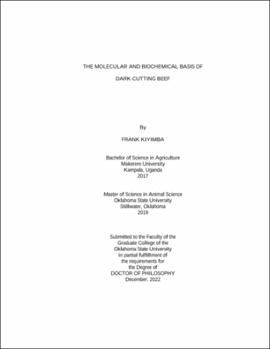| dc.description.abstract | Dark-cutting beef is a meat quality defect where beef fails to have a characteristic bright-red color typical of normal-pH beef. The occurrence of dark-cutting beef is associated with a high muscle pH resulting from defective glycogen metabolism pre-slaughter. Although the factors predisposing animals to muscle darkening have been previously examined, the molecular and mechanistic basis for this occurrence remains largely unknown. In this work, we investigate the molecular and biochemical basis of dark-cutting beef by integrating proteomics, metabolomics, and enzyme assays coupled with bioinformatics analyses. Here, we show that dark-cutting beef is caused, in part, as a consequence of over-proliferation of mitochondria supported by the up-regulation of proteins involved in mitochondrial biogenesis, mitochondrial electron transport, calcium homeostasis, and fatty acid metabolism. However, in atypical dark-cutting beef, “a condition where beef has slightly above normal-pH but present dark-colored muscles”, we show that the enzymes involved in glycogen metabolism create a threshold for muscle darkening rather than the metabolites expression profiles. Furthermore, examination of postmortem wet-aging of dark-cutting beef suggests enhanced muscle proteolysis compared with normal-pH beef supported by up-regulation of the proteasome and oxidative proteins and more abundance of TCA-, nucleotide-, and free amino acids metabolites. This implies that the greater mitochondrial content in dark-cutting beef could contribute to more oxidative stress during postmortem aging. Finally, we observed that the inherent substrate inhibition mechanisms in dark-cutting beef regulate muscle pH decline. Therefore, by supplementing glycogen in an in-vitro system, we showed that postmortem muscle pH decline could be restored in dark-cutting muscles. Thus, findings from this study show that understanding the pathways and biochemical processes underpinning muscle darkening in beef, can increase detection and help in designing strategies to minimize the occurrence while improving economic benefit. | |
